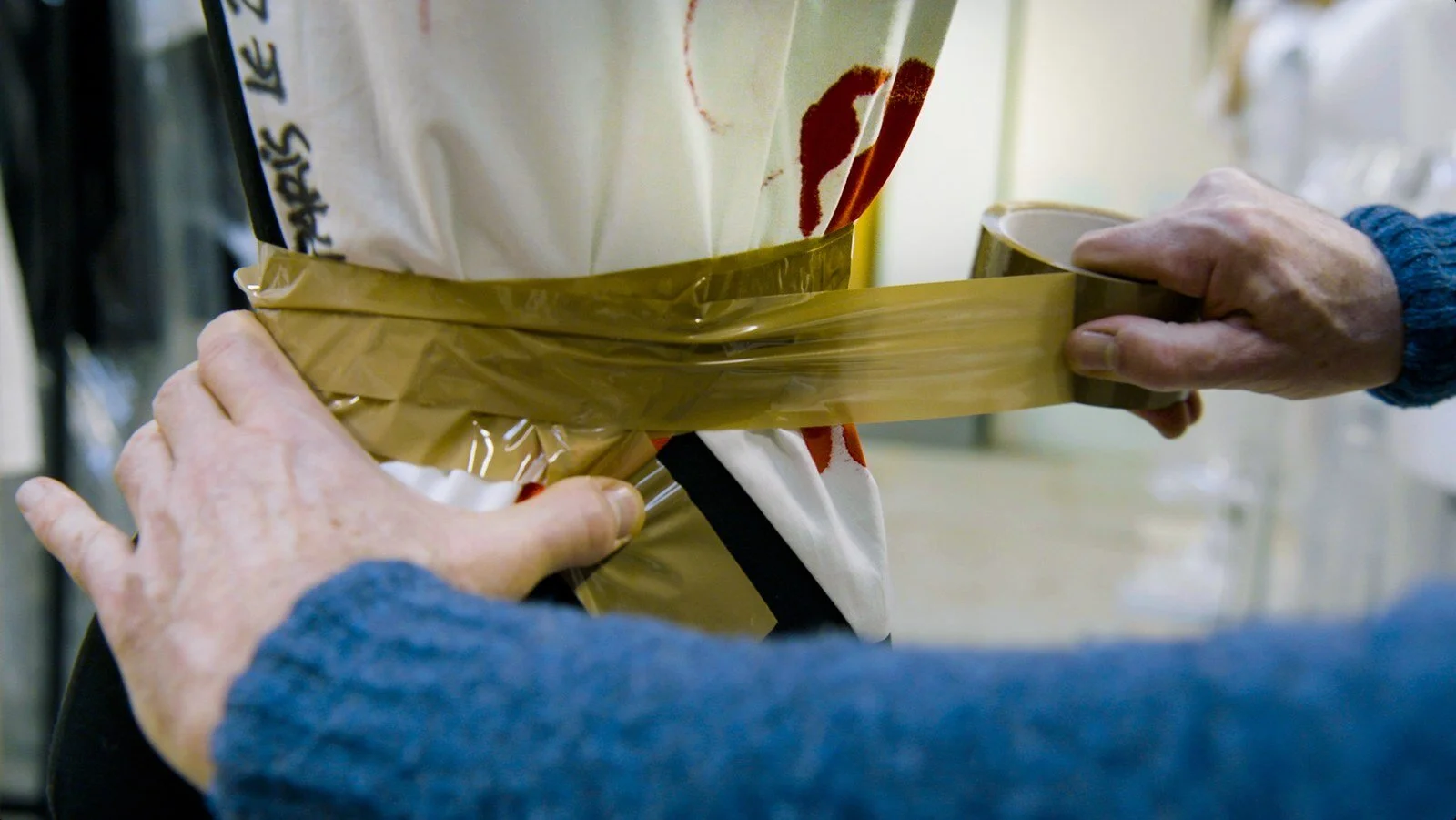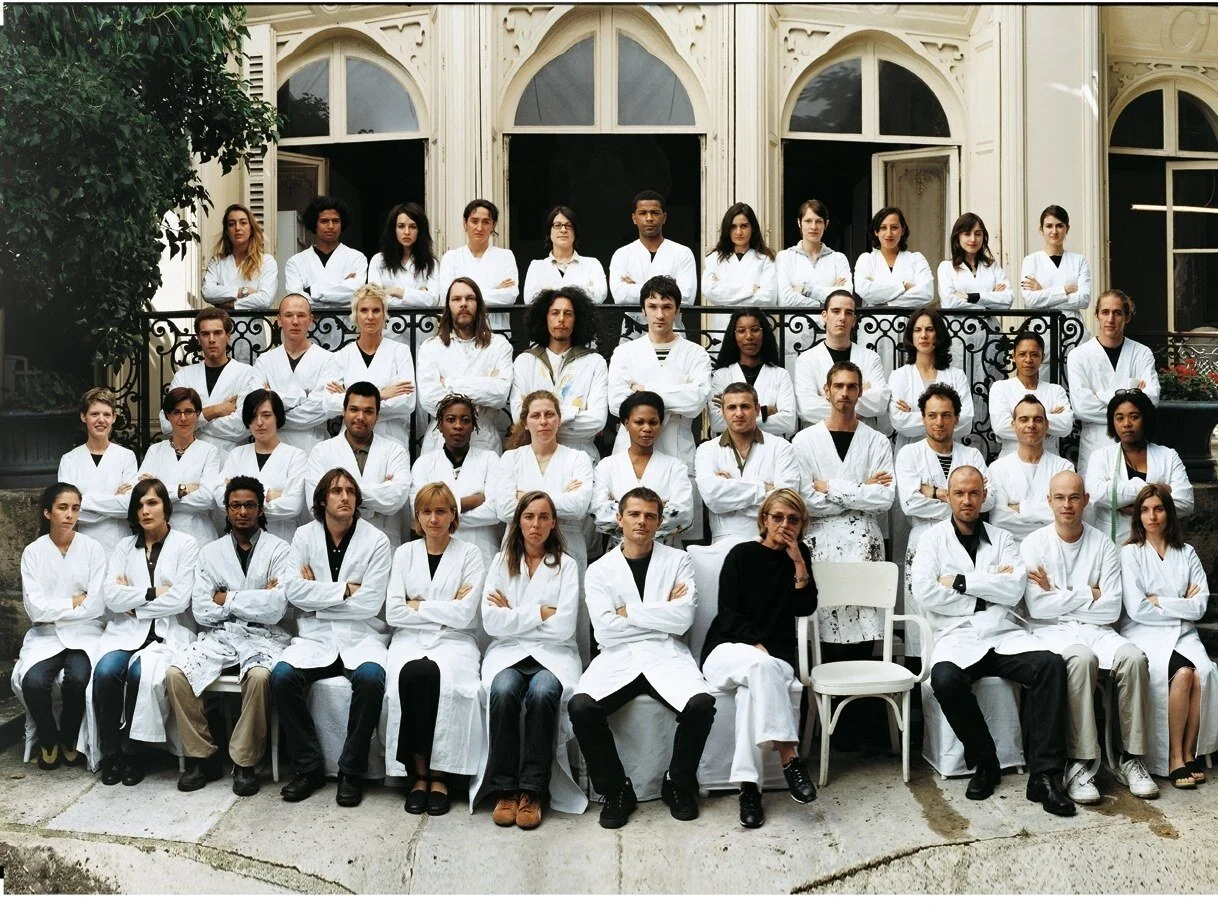Martin Margiela: In His Own Words
/“Have you said everything you wanted to say in fashion?”
“No.”
That is the promise dangling at the end of Reiner Holzemer’s new documentary, Martin Margiela: In His Own Words, which premiered at the Doc NYC film festival last week. After 90-ish minutes of exposition from Margiela himself, who remains so elusive only his hands were filmed, Holzemer abruptly asks if fashion’s most celebrated genius is really, truly, undeniably done with it all. No. And then the screen cuts to black.
Any hopes of Margiela’s return to fashion will have to be sidelined for now, however. “He won’t work as a fashion designer anymore in his life—probably,” Holzemer told Vogue during an interview on the day of the film’s world premiere. “But you never know. We all love that the movie ends with this. It gives you a nice smile in the end, which is important.”
Holzemer’s film is not so much about where Martin Margiela is in 2019—the designer speaks of painting and sculpting, though those pursuits are not shown in the documentary—or what he might do in 2020, but about the 20 years from 1989 to 2009 during which Margiela operated his eponymous label. As a portrait of a finite body of work—the two decades of Martin Margiela runway shows—Holzemer’s film operates as a circle: It begins with Margiela’s Spring 2009 20th-anniversary show, his final one, then waltzes through a chronology of his life and career with the help of talking head interviews with Olivier Saillard, Carla Sozzani, Stella Ishii, Pierre Rougier, Cathy Horyn, and more of his models, collaborators, friends, and critics, before finishing back at Margiela’s swan song.
That format allows for deep dives into the designer’s key collections and career points. It helps that the documentary was made alongside the preparation and installation of the Palais Galliera’s 2018 exhibit, Margiela / Galliera, 1989-2009. For 42 days, Holzemer, sometimes alone, sometimes with a skeleton crew, would visit the museum or Margiela’s studio and get the designer talking. “Which garments are important, which do you think we have to include in the movie?” Holzemer says he asked Margiela as they began filming. There were 110 items in the exhibit, and he made a list of 90 for the film.
Ultimately, they settled on around 70 crucial pieces, which are presented with voiceovers by the designer. These range from his cork necklaces—which we see Margiela making with his own hands as the film starts—through his doll collection of 1994 and his stockman collection of 1997. “I’m very grateful that he opened up and he trusted me so much. It was not always easy for him,” Holzemer says. The hits are all here: The Spring 1990 show staged in a playground (“The most magical show of my career”), his time as creative director of Hermès (“For me, luxury is the perfect balance between quality and comfort and if I could go farther I would add timelessness”), the Spring 2007 show that worked to establish new Margiela codes (“I wanted to be different, new, without rejecting my fans…. It felt like a new beginning.”)
As the movie seeks to illustrate, Margiela did almost everything that is on trend in contemporary fashion first: He had street cast shows, he popularized the long, lean lines of the ’90s, he made a reissue collection for his 10th show, he pushed and pushed and pushed the creative bounds of what a fashion show was and what a fashion brand could look be. “I hope that, first of all, his name and the work stays alive, that people discover how influential he was, how much of what we see today on the catwalks is sometimes copied one-to-one—I don’t need to mention the names, I’m not an expert of that,” Holzemer says. “I think if the world knows where the Margiela influence comes from, that would make me very happy.”
Of course, what Margiela also did first was what he did last: Leave fashion for good. “I was not made to cope with that system as well as Jean Paul Gaultier,” says Margiela, who was Gaultier’s assistant before launching his own label. “Jean Paul always said, ‘Martin you’re too serious,’ and it’s true […] I am probably too serious for that world.” Margiela’s departure is a story that has become familiar within fashion’s creative industries: the struggle to translate a personal passion into a corporate consumer product. It’s here that the film touches a nerve, but instead of prodding it, it lets the audience read between the lines. The sale of Maison Martin Margiela to Renzo Rosso’s Only the Brave group, the departure of Margiela’s partner Jenny Meirens, and Margiela’s own absence are covered without too much emotionality, although fashion insiders will be able to interpret Margiela’s careful language about the reason for his departure: “At the end, I became, in a certain way, an artistic director in my company and that bothered me because I am a designer […] I am not a creative director who directs his assistants.”
The irony of Holzemer’s delicate portrait of an artist in absence is that it was Margiela’s replacement who inspired the director to take an interest in fashion as a subject. (Holzemer worked on films about photographers before taking up fashion with the documentary Dries about Dries Van Noten in 2017.) “Why I wanted to make a fashion movie was the Galliano story,” Holzemer says, referencing the public meltdown that got John Galliano fired from his position at Christian Dior. After entering rehab, Galliano was named the artistic director of Maison Margiela in 2015. “I read a big article about the pressure fashion designers are under. I was really touched by that article. It was a bad thing that Galliano did, but in that article it explained that some of the designers take drugs to survive. Alexander McQueen killed himself. That was the thing that caused my sensitivity for the profession, for the world, for the industry. […] How do I say it? I work hard too, but the fashion designers work so hard under such pressure wherever that pressure comes from, sometimes it’s big companies, sometimes it’s yourself. That it’s really a challenge to remain in that business for so long and to survive in that business in a healthy way.”
Holzemer indicates that he knows there is a lot of pain here for Martin Margiela—but he won’t say anything about it, nor does much of that tension make it to the screen. “You don’t see that in the movie. Often I was looking at his face, the camera was on the wall, it was only listening, and I thought, It would be so strong if I could show your face now. I still have it in my memory. It was often very touching. The story was always surprising because you could not read it. He told it for the first time: How he felt after the first show, how he felt after 10 years, and how he felt in the end. Nobody knew that before.”
Even with these small, tender moments of Margiela’s vulnerability that reveal the glimmer of a sensitive, caring, gentle man, this documentary doesn't go beyond affirming many of the myths already made about Martin Margiela. Yes, there are incredible glimpses into his childhood in Genk, Belgium, and his sketchbooks—with every year of the designer’s life saved by his mother, Léa Bouchet—but the final film still works behind layers of abstraction. It is mostly about the exhibit, it is without its star’s visage, and even the voice over of Margiela’s lyrical Franco-Belgian intonation is slightly engineered to cloak the reality of what Martin Margiela actually sounds like. In Dries, one of the most compelling moments is one that seems almost incidental: Van Noten and his partner, Patrick Vangheluwe, silently snipping flowers from their garden and arranging them throughout their house, not a word spoken, not a nod exchanged. “You can talk a lot about perfectionism or obsession but there you see it, you feel it, and it says it all,” Holzemer says of that scene.
Martin Margiela: In His Own Words never gets to that show-don’t-tell moment because so much of the story has to be told in voiceover or in interview segments. To adequately show the brilliance of Martin in the year 2019—30 years after his seismic start and a decade after that anniversary show that proved to be his last—something really unexpected would have to happen in the film. For the most part, it doesn’t. But maybe it’s best that the curtain stays drawn a little longer. By protecting Margiela from the cold gaze of a camera, Holzemer allows us superfans to keep our fashion-world hero alive, no flaws, no tensions, no negativity; only these memories and the knowledge that the heart behind the Margiela universe is still beating. Toward the end of the film, Holzemer shows the opening of the Galliera exhibit, long lines shivering in Paris’s March cold. Inside, Vogue editors gasp at the installation, Raf Simons gestures at a mannequin, Rick Owens contemplates in admiration. The legend of Martin Margiela lives on. And then there’s always the promise of his return….
Source: Vogue
FASHIONADO








